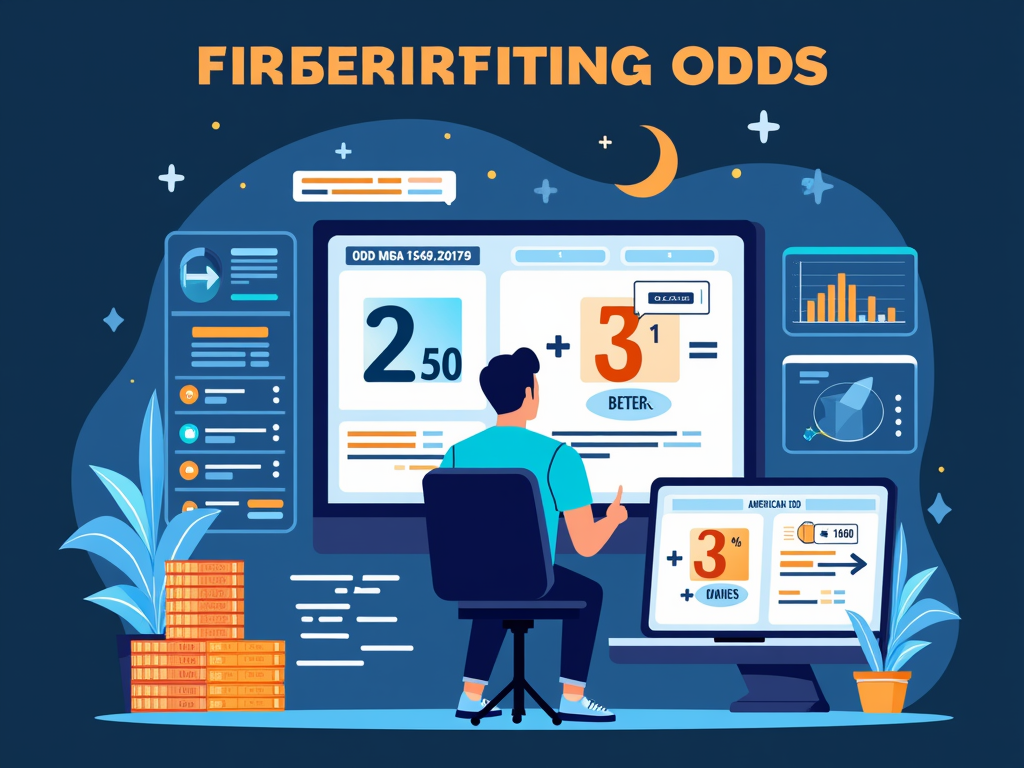Consistent Profits in Sports Betting
Consistent profits in sports betting stem from mastering key fundamentals and sticking to a proven system. Success requires odds analysis, careful money management, and proper record keeping while leveraging multiple betting platforms.
Key Takeaways
- Calculate implied probabilities from betting odds to identify value opportunities and make informed decisions
- Maintain strict bankroll management by limiting bets to 1-3% of your total betting funds
- Focus on specializing in specific sports or leagues rather than spreading yourself too thin
- Keep detailed records of all bets, including stakes, odds, and outcomes to analyze performance
- Use multiple sportsbooks to shop for the best odds and take advantage of different promotions
My Strategic Approach
My strategic approach focuses on converting odds into probabilities to spot profitable opportunities. By limiting each wager to a small percentage of my total bankroll, I protect against extended losing streaks while maximizing long-term growth potential.
Specializing in select sports gives me deep knowledge and an edge versus trying to handicap everything. I track every bet in a spreadsheet, analyzing the data to refine my process and identify winning patterns.
Multiple betting accounts let me compare prices and grab the best available odds. This practice alone can boost profitability by 2-3% annually. Line shopping takes extra effort but pays off through improved returns over time.
Discipline and Long-Term Success
A winning strategy requires discipline to follow proven systems rather than chasing losses or betting based on emotion. By combining analytical skills with strict bankroll rules and detailed tracking, I create sustainable profits through sports betting.
Why Understanding Betting Odds is Your First Step to Success
Converting Odds to Probabilities
I can’t stress enough how crucial it is to grasp the relationship between odds and probability before placing any bets. The formula is straightforward — take 1, divide it by the decimal odds, and multiply by 100 to get the implied probability percentage. Let me break this down with a simple example: if you see odds of 2.50, the calculation would be:
1 ÷ 2.50 × 100 = 40%
This means the bookmaker believes there’s a 40% chance of this outcome happening.
Different Odds Formats and Their Meanings
Betting odds come in three main formats, and understanding each one will help you make smarter betting choices. As a bettor looking to master sports betting fundamentals, you’ll need to recognize these variations:
- Decimal Odds (European): The simplest format showing your total return per unit stake (e.g., 2.50 means $2.50 return for every $1 bet)
- Fractional Odds (UK): Displayed as a fraction like 3/1, showing profit relative to stake
- American Odds (Moneyline): Uses plus and minus signs (e.g., +150 or -200) to show profit or required stake
While moneyline betting is popular in America, decimal odds make probability calculations much easier. The odds don’t just reflect pure mathematics — they also indicate how other bettors are wagering and how bookmakers adjust their margins.
I find that focusing on implied probability rather than just the odds helps spot value opportunities. For instance, if I calculate a 40% chance of winning but the odds suggest 30%, that’s potentially a value bet. This approach to wagering wisely gives you an edge over casual bettors who bet purely on instinct.
Converting between different odds formats might seem tricky at first, but it becomes second nature with practice. The key is understanding that regardless of format, odds tell you two critical pieces of information:
- Your potential payout
- The implied probability of an outcome
Remember that odds fluctuate based on betting activity. If lots of money comes in on one side of a bet, bookmakers will adjust the odds to balance their books. This is why you might see different odds at different sportsbooks for the same event — creating opportunities for savvy bettors to find the best value.

Master Your Money: Essential Bankroll Management Principles
Smart bankroll management sits at the foundation of successful sports betting. I’ve found that setting the right betting unit size makes all the difference between sustainable betting and going broke. The sweet spot for standard betting units falls between 1-3% of your total bankroll.
Setting Your Base Unit Size
Let me break down what this means in practical terms. If you’re starting with a $1,000 bankroll and choose to bet 2% per wager, your standard unit size would be $20. This conservative approach helps protect your bankroll during inevitable losing streaks.
Here’s a quick look at recommended unit sizes based on different bankrolls:
- $500 bankroll: $5-15 unit size (1-3%)
- $1,000 bankroll: $10-30 unit size (1-3%)
- $5,000 bankroll: $50-150 unit size (1-3%)
I recommend starting with flat staking, where you bet the same amount on each wager. While percentage staking can work for experienced bettors, flat betting offers better protection for your bankroll as you build experience.
Professional discipline means sticking to your predetermined unit size, especially during losing periods. The urge to chase losses by increasing your stake can destroy your bankroll quickly. I’ve seen countless bettors fall into this trap, but maintaining strict betting discipline separates successful bettors from those who bust their bankrolls.
Think of your bankroll as business capital – it needs careful management to generate returns. By keeping each bet between 1-3% of your total funds, you’re giving yourself room to weather variance and bad runs while still making meaningful wagers.
This careful approach to money management pairs perfectly with understanding different bet types and finding value opportunities. Remember, even the sharpest betting strategies can fail without proper bankroll management backing them up.
Finding Value Bets: The Key to Long-Term Profit
While understanding sports betting fundamentals is essential, identifying value bets sets apart successful bettors from casual players. A value bet exists when the true probability of an outcome exceeds the implied probability set by the bookmaker.
Let me break this down with a clear example: If a bookmaker sets odds suggesting a 40% chance of victory, but my analysis shows the true probability is 45%, I’ve found a potential value bet. This 5% difference represents an edge that can lead to consistent profits over time.
Calculating Expected Value (EV)
The mathematical formula for determining Expected Value helps quantify potential profit opportunities:
EV = (Win Probability × Win Amount) – (Loss Probability × Loss Amount)
To make smart decisions in sports wagering, I focus on these key aspects when searching for value bets:
- Compare my calculated probabilities against bookmaker odds
- Factor in all relevant team statistics and conditions
- Consider recent form and head-to-head records
- Account for injuries and team news
- Monitor line movements and market reactions
Value betting isn’t about picking winners – it’s about finding odds that offer more value than they should. I might spot value in a losing team if their actual chances are better than what the odds suggest. This approach requires patience and discipline, as value bets don’t always win, but they’re profitable in the long run.
Even when betting on popular markets like moneylines and spreads, I always assess whether the odds accurately reflect true probabilities. Sometimes the best value lies in less popular markets or prop bets where bookmakers might not be as sharp with their pricing.
The process of finding value demands consistent research and analysis. I track my predictions against actual outcomes, refining my probability assessments over time. This data-driven approach helps sharpen my ability to spot genuine value opportunities and avoid emotional betting decisions.

Become an Expert Through Research and Specialization
Building Your Knowledge Foundation
Instead of spreading yourself thin across multiple sports, I recommend focusing your attention on specific leagues or bet types. By specializing in player prop betting markets, or dedicating time to master one league, you’ll develop a sharper edge in your betting strategy.
Let’s say you’re passionate about soccer – concentrate on the English Premier League rather than trying to keep up with five different leagues. This focused approach lets you track essential metrics like Expected Goals (xG), which helps predict team performance with greater accuracy.
For NFL enthusiasts, getting familiar with Defense-adjusted Value Over Average (DVOA) provides crucial insights into team efficiency. Basketball bettors should pay attention to Player Efficiency Rating (PER) when making player-specific wagers.
Your research should cover these key areas:
- Current team and player form
- Injury reports and team news
- Weather conditions for outdoor sports
- Team motivation factors (rivalries, qualification battles)
- Head-to-head historical performance
- Recent schedule intensity
Going deeper into less popular markets can give you a significant advantage. While most bettors focus on major leagues and obvious betting options, I’ve found that specializing in niche markets often reveals better opportunities for value bets.
Remember to blend statistical analysis with qualitative research. Numbers tell part of the story, but watching games, following team news, and understanding coaching strategies adds context to your betting decisions.
This balanced approach between data and observation helps you spot trends before they’re reflected in the betting lines. For example, a team’s tactical shift might not show up immediately in the statistics, but could significantly impact their upcoming performance.
Don’t forget to maintain detailed records of your research and betting outcomes. This documentation helps identify which aspects of your analysis are most effective and where you need to adjust your strategy.
Track Everything: Essential Record Keeping for Success
I can’t stress enough how crucial detailed bet tracking is for your sports betting success. Without proper records, you’re essentially flying blind and missing out on valuable insights that could boost your profits.
Key Data Points and Performance Analysis
Your betting records should capture several essential data points for every wager. Here’s what I specifically track for maximum effectiveness:
- Date and time of the bet placed
- Sport and specific event details
- Type of bet (parlay, player props, or moneyline wagers)
- Stake amount and odds received
- Final outcome and profit/loss
- Brief notes on decision-making factors
To calculate your Return on Investment (ROI), simply use this formula: (Total Profit / Total Amount Staked) x 100. This percentage gives you a clear picture of your betting performance over time.
I’ve found that spreadsheet tools like Excel or Google Sheets work perfectly for tracking these metrics. If you prefer a more structured approach, specialized apps like Betsperts or Action Network offer comprehensive tracking features with built-in analysis tools.
By maintaining detailed records, I can spot profitable patterns in my betting strategy and quickly identify areas needing improvement. For instance, I might notice higher success rates with certain sports or specific bet types, allowing me to adjust my approach accordingly.
Breaking down performance by different categories reveals valuable insights:
- Win rates across different sports
- Success with various odds ranges
- Performance by bet type
- Profit/loss trends by stake size
- Time-based patterns (daily, weekly, monthly)
This data-driven approach helps maintain discipline and makes it easier to stick to a successful betting strategy. By reviewing these records regularly, I can make informed decisions about where to focus my efforts and which betting patterns to avoid.
Shop Smart: Maximizing Profits Through Multiple Bookmakers
Understanding the Impact of Odds Differences
I can’t stress enough how small odds variations between sportsbooks can make a huge difference to your bottom line. Let’s look at a clear example — placing a $10 bet at odds of 1.90 versus odds of 1.98 results in an $0.80 profit difference. While this might seem minor at first glance, these small edges add up substantially over hundreds of bets throughout a season.
Essential Sportsbook Selection
To get the best possible odds, I recommend creating accounts with several major sportsbooks. The top operators for understanding sports betting fundamentals and competitive odds include:
- DraftKings – Known for competitive odds on major sports leagues
- FanDuel – Offers excellent live betting options and odds boosts
- BetMGM – Features strong international sports coverage
- Caesars – Provides frequent promotions and competitive lines
- bet365 – Strong for both pre-game and live betting markets
Having multiple sportsbook accounts isn’t just about convenience — it’s a crucial strategy for making smarter betting decisions. By comparing odds across different platforms, I can consistently secure the best value for my bets. This practice, known as line shopping, is particularly important for popular betting markets where even slight odds differences can impact your profits.
I’ve found that line shopping becomes especially valuable when placing larger bets or betting frequently. The cumulative effect of getting better odds can mean the difference between a profitable and unprofitable betting season. For instance, if you’re placing 500 bets per year at an average stake of $100, finding consistently better odds could translate to thousands of dollars in additional profits.
The key is to maintain active accounts with multiple bookmakers and check odds regularly before placing bets. This might take a few extra minutes, but the potential return on investment makes it worthwhile. I also suggest keeping your accounts funded to take advantage of favorable odds quickly, as lines can move rapidly, especially in prop betting markets.
By spreading your action across different sportsbooks, you’re also protecting yourself from account limitations that might occur if you consistently win at a single bookmaker. Plus, you’ll have access to a wider range of promotions, odds boosts, and betting markets, which can further boost your potential returns.

Sources:
Investopedia – Betting Strategies Used by the Pros
Pinnacle – Betting Strategy Articles
Action Network – How To Develop A Sports Betting Model
Smarkets Help Centre – How to calculate betting margins
Journal of Sports Analytics





